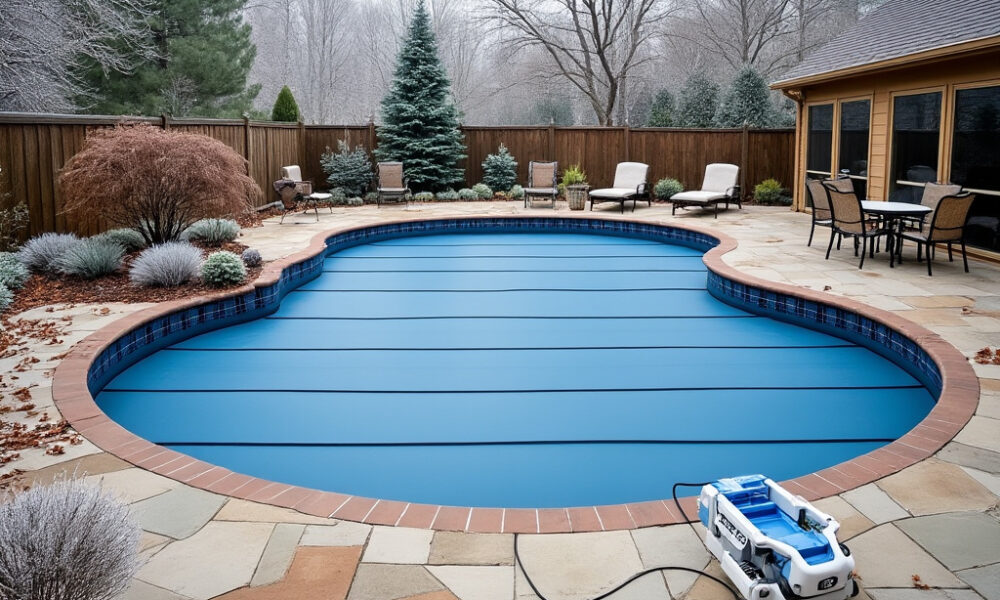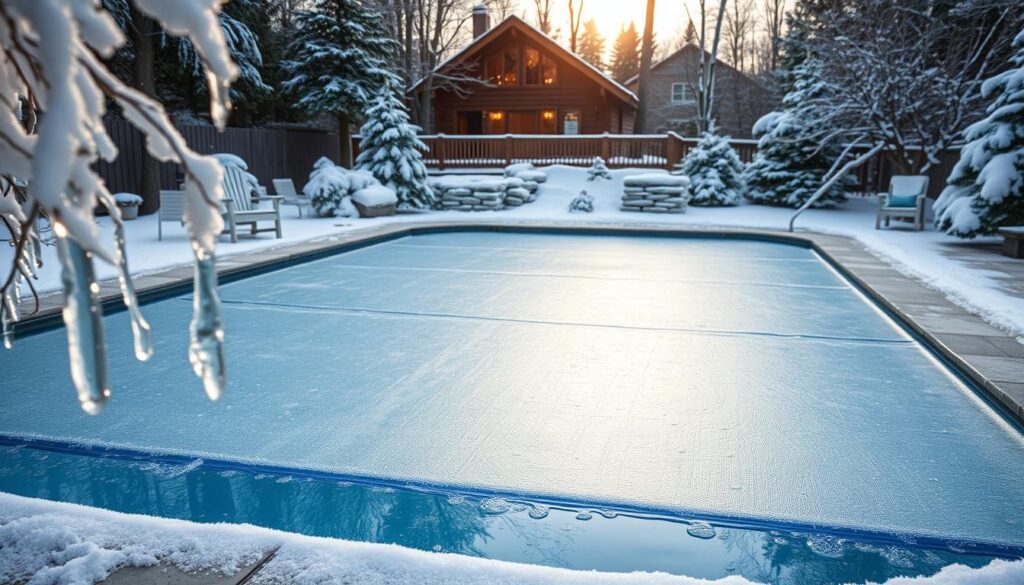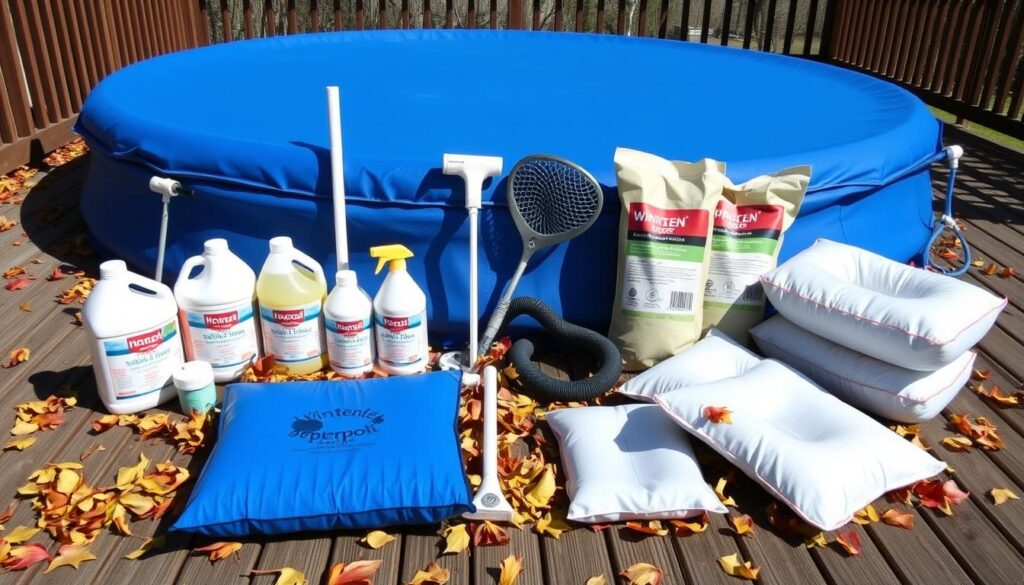
Pool Winterization: Protect Your Pool This Winter
As the weather gets colder, it’s time to protect your backyard pool. Whether it’s in-ground or above-ground, winterizing is key. It keeps your pool safe and ready for next year without trouble.
By taking the right steps, you can avoid damage from freezing and algae. This ensures your pool stays in great shape all winter.

Key Takeaways
- Winterizing your pool is crucial to protect it from freezing temperatures and reduce the risk of problems when reopening it in the spring.
- The winterization process includes cleaning the pool, balancing the water chemistry, and properly draining water from the pool and equipment.
- Proper pool winterization can help prevent damage from freezing, algae growth, and other contaminants.
- Taking the time to close your pool correctly can ensure a smooth and hassle-free reopening in the spring.
- Consulting with professional swimming pool contractors or builders can help ensure your pool is properly winterized and protected.
Introduction: Why Pool Winterization is Essential
As the weather gets colder, it’s key to focus on pool winterizing. This step helps protect your pool and makes opening it in the spring easier. Cold weather pool maintenance is vital to avoid expensive damage and stop algae growth during the off-season.
Preventing Freeze Damage
Freezing water can expand and damage your pool’s pipes and equipment. To prevent this, drain lines, add anti-freeze, and cover your pool securely. This way, your pool stays safe from freezing harm.
Avoiding Algae Growth
A winterized pool fights off algae growth better in the cold months. If you skip winterizing, algae can build up, needing a lot of cleaning and chemicals to fix.

Proper pool winterizing saves your investment and reduces repair costs. It also makes opening your pool in the spring stress-free. The effort you put into cold weather pool maintenance will be worth it, keeping your pool ready for fun.
Supplies and Tools Required for Pool Winterization
As the weather gets colder, it’s time to get your pool ready for winter. You’ll need a few key supplies and tools. A strong pool cover, like a safety or winter cover, is essential to keep your pool safe.
You’ll also need a winterizing chemical kit. It should have shock, algaecide, and pH balancers to keep your water balanced. A blower or shop vac helps clear water from lines, and expansion plugs prevent freeze damage.
Other important items include a pool brush, skimmer net, and submersible pump to lower the water level. For above-ground pools, an air pillow is crucial to handle ice expansion. Lastly, a water testing kit helps you keep the water chemistry right.
Having all these pool winterization supplies, pool closing equipment, and pool winterizing tools ready before you start will make the process easier and quicker. This ensures your pool is well-protected for the cold months.

Remember, proper winterization is key to avoid expensive damages and make spring reopening smooth. By getting the right pool winterization supplies, pool closing equipment, and pool winterizing tools, you can be sure your pool will be ready for the warm weather.
Timing: When to Start Winterizing Your Pool
As the weather gets cooler, it’s important to know when to start winterizing your pool. You should begin when the temperature stays below 65°F (18°C). This is key to stop algae growth and finish winterizing before the first frost.
Monitoring Temperature Changes
In colder areas, start winterizing in early to mid-fall. In warmer places, late fall or early winter is enough. Watch the nighttime temperatures and check the weather forecast. This helps avoid damage from freezing and algae in the off-season.
The signs to start winterizing your pool include:
- Consistent nighttime temperatures below 65°F (18°C)
- Forecasts predicting upcoming frost or freezing conditions
- Leaves and debris accumulating in the pool
By watching temperature changes and keeping up with seasonal pool maintenance, you can get your pool ready for winter. This protects it from damage and makes spring opening easier.
Steps to Winterize an Inground Pool
Winterizing your inground pool is key to avoid freeze damage. It also makes opening it in spring easier. Here’s a simple guide on how to winterize an inground pool:
Balancing Water Chemistry
First, test and adjust the pool water chemistry. Aim for pH levels between 7.4–7.6 ppm, total alkalinity of 80–120 ppm, and calcium hardness of 200–400 ppm. This keeps the water quality good and stops corrosion or scaling.
Deep Cleaning the Pool
Next, vacuum, brush, and skim the pool well. This removes all debris, keeping the pool clean. It also stops staining and algae growth in winter.
Adding Winterizing Chemicals
Then, use a pool winterization kit. It usually has chlorine shock, algaecide, and a chemical to stop staining and scaling. These chemicals keep the water quality good and stop algae in cold months.
Draining and Plugging Lines
Drain the pool water level 6-12 inches below the skimmer. Then, use an air compressor to clear water from lines. Finally, seal the lines with expansion plugs to keep water out.
Installing a Winter Pool Cover
Finally, put on a tight-fitting winter pool cover. It can be a safety cover or a standard winter cover. This keeps debris out and protects the pool.
By doing these steps, you can prepare your inground pool for winter. It will be ready for fun when spring comes.
Winterizing an Above-Ground Pool
As winter gets closer, it’s key to winterize your above-ground pool. This prevents freeze damage and keeps it in good shape for next year. The steps to winterizing an above-ground pool are similar to those for inground pools, but there are some differences.
Using Air Pillows
Installing air pillows is a crucial step in winterizing an above-ground pool. These pillows go in the pool’s center. They absorb ice expansion during winter. This protects the pool’s walls from ice damage.
Securing the Pool Cover
After balancing the water and adding winter chemicals, securing the pool cover is next. Use a tight-fitting winter cover made for your pool. Make sure it’s tightly fastened to stop wind damage and keep out debris. This is vital for preparing above ground pools for winter and keeping them clean.
By following these steps and using the right above ground pool winterization methods, you can protect your pool. This way, it will be ready for use when the weather warms up again.
Winterizing a Saltwater Pool
Winterizing a saltwater pool is a bit different than a traditional chlorine pool. First, test and adjust the salt levels. They should be between 2,700 and 3,400 ppm. This prevents corrosion and makes spring opening easier.
Then, clean and store the salt cell or chlorine generator. This part is key for water quality during winter. Don’t forget the usual steps like balancing water chemistry and adding winterizing chemicals. Also, install a strong pool cover.
- Maintain salt levels between 2,700 and 3,400 ppm
- Clean and store the salt cell or chlorine generator
- Balance water chemistry (pH, alkalinity, calcium hardness)
- Add winterizing chemicals to prevent algae growth
- Install a durable, secure pool cover
By following these steps to winterize a saltwater pool, you protect it from freezing damage and algae. This makes spring start-up easier, saving you time and money.
Common Mistakes to Avoid During pool winterization
As the pool season ends, it’s key to winterize your pool right. This prevents costly damage in the cold months. Many pool owners make mistakes that can cause problems when they reopen in spring. Avoiding these mistakes can keep your pool safe all winter.
One big mistake is closing the pool too soon. This can let algae grow. Not balancing the water chemistry can also cause problems like corrosion or algae. Not cleaning the pool well before winterizing it can let in contaminants.
- Forgetting to drain the pool or equipment can result in freeze damage, which can be expensive to repair.
- Improperly securing the pool cover can lead to wind damage or water accumulation, further compromising the pool’s integrity.
By knowing these pool winterization mistakes, you can avoid pool damage during winter. This makes the next swimming season easier. Taking the time to prepare your pool for winter can save you from common pool closing issues and the trouble they bring.
Potential Problems and Troubleshooting
Even with proper winterization, issues can still arise. It’s important to watch for problems and fix them quickly. This helps avoid damage and expensive repairs.
Cover Concerns
Leaks, sagging, or holes in the pool cover are signs of trouble. A damaged cover can harm your pool. So, it’s key to replace it to protect your investment.
Regular checks and quick repairs can help manage cover issues. This way, you can stay on top of any problems.
Frozen Pipes
If you think pipes are frozen, don’t try to thaw them yourself. It’s safer to call a professional pool technician. They know how to thaw pipes without causing more harm.
By being alert and fixing pool issues during winter, like dealing with frozen pipes and pool cover problems, you can avoid bigger problems. This ensures your pool is ready for the warmer months.
- Pool cover failures can happen due to age, wear, or debris like tree limbs.
- Damage like rips and tears can let sunlight in, causing algae to grow.
- Winter pool covers keep debris out of the pool during the off-season.
- To stop damage from freezing, use methods like blowing out lines, using antifreeze, and air pillows under covers.
- In milder areas, running the pump during freezes can help, especially with automated systems.
- Regular checks for leaks, damage, and water chemistry are crucial. This keeps the pool safe and ready for spring.
Conclusion
Winterizing your pool is key to keeping it in good shape for spring. This process includes cleaning, balancing the water, draining equipment, and covering the pool. Doing this right protects your pool from damage and keeps it algae-free.
Whether you have an inground or above-ground pool, following the right steps is important. Adjusting the calcium hardness and using winterizing chemicals are crucial. These actions help your pool stay in great condition all winter.
By closing your pool correctly, you’ll have a great pool next spring. With the right care, your pool will be ready for fun when the weather warms up. So, invest time in winterizing your pool now for a smooth opening next year.
FAQ
What is the importance of properly winterizing a swimming pool?
Winterizing your pool is key to keep it safe from freezing. It also helps avoid problems when you reopen it. You’ll need to clean the pool, balance the water, and drain it. This way, you prevent damage and keep the water clean.
What supplies and tools are needed to effectively winterize a pool?
You’ll need a pool cover, a chemical kit, and a blower or vac for water lines. Don’t forget expansion plugs, a brush, net, and a submersible pump. For above-ground pools, an air pillow is essential.
When is the best time to start the pool winterization process?
Start winterizing when the temperature stays below 65°F (18°C). This stops algae and lets you finish before frost. In cold areas, start early fall. In warmer places, late fall or early winter is fine.
What are the key steps for winterizing an inground pool?
For an inground pool, balance the water, deep clean, and add winter chemicals. Then, drain and plug the lines, and cover the pool.
How does the process differ for winterizing an above-ground pool?
Winterizing an above-ground pool is similar, but you need to add air pillows. These pillows protect the walls from ice damage.
What extra steps are required for winterizing a saltwater pool?
For saltwater pools, check and adjust the salt levels to 2,700 to 3,400 ppm. Clean and store the salt cell to keep water quality up.
What are some common mistakes to avoid when winterizing a pool?
Avoid closing too early, not balancing the water, and not cleaning the pool well. Don’t forget to drain the pool and equipment, and secure the cover right.
What are some potential problems that can arise during the off-season, and how can they be addressed?
Problems like cover damage and frozen pipes can happen. If pipes freeze, call a pro to avoid more damage.

